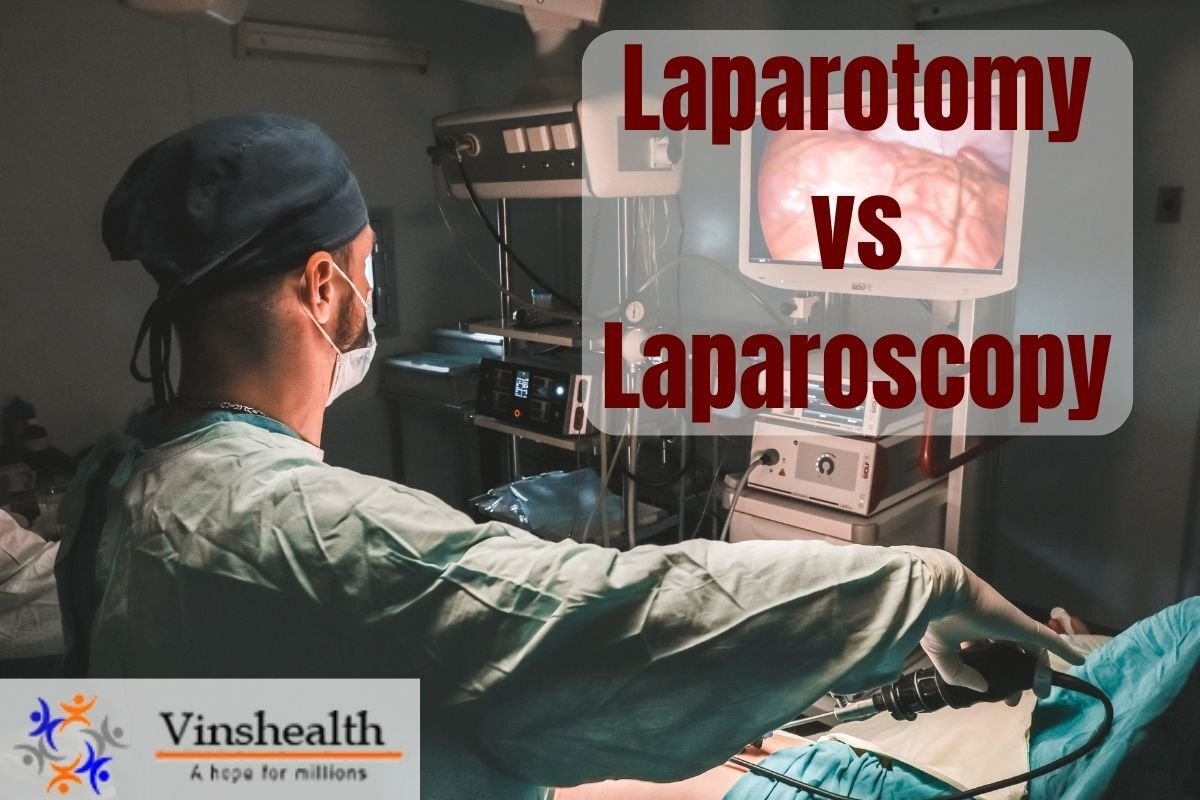Laparotomy Vs Laparoscopy: What is Laparotomy, Surgical and Advantages
- 2023-09-29
- Laparotomy Surgical, Laparoscopy Surgical
In the realm of modern medicine, surgical techniques have evolved tremendously over the years, offering patients safer and less invasive options for various medical conditions. Laparotomy and laparoscopy are two distinct surgical approaches that serve unique purposes in the world of abdominal surgery. While both are employed to diagnose and treat a wide range of abdominal and pelvic issues, they differ significantly in terms of invasiveness, recovery time, and potential complications.
In this comprehensive blog, we will delve deep into the differences between laparotomy and laparoscopy, shedding light on their respective advantages, disadvantages, and the conditions they are best suited for. By the end, you'll have a thorough understanding of these two surgical techniques and be better equipped to make informed decisions about your healthcare or to provide insights into the field of surgery.
Table Of Content
- What is Laparotomy
- Indications for Laparotomy
- Laparotomy Procedure
- The Advantages and Disadvantages of Laparotomy
- What is Laparoscopy
- Indications for Laparoscopy
- Laparoscopy Procedure
- The Advantages and Disadvantages of Laparoscopy
- Choosing Between Laparotomy and Laparoscopy
- Frequently Asked Questions (Laparotomy vs Laparoscopy)
What is Laparotomy
Laparotomy is a conventional surgical procedure that involves making a large incision in the abdominal wall to gain access to the abdominal or pelvic cavity. Also known as open surgery, laparotomy has been practiced for centuries and remains a crucial approach in many medical situations.
Indications for Laparotomy
Laparotomy is typically employed in cases where the surgeon needs a direct and unobstructed view of the abdominal or pelvic organs. Some common indications for laparotomy include:
- Emergency surgeries: Laparotomy is often the go-to choice in emergency situations, such as trauma, bowel obstruction, or ruptured abdominal organs. The large incision allows rapid access to the affected area, enabling immediate intervention.
- Complex surgeries: In cases involving extensive surgical procedures or organ transplantation, laparotomy provides surgeons with the necessary space and precision required to perform intricate maneuvers.
- Tumor removal: For larger tumors or cancers affecting multiple organs in the abdominal or pelvic region, laparotomy offers better visibility and access for complete tumor resection.
- Bowel surgery: Procedures like colectomy or bowel resection, where the surgeon needs to remove a portion of the intestine, often necessitate laparotomy due to the precise nature of the surgery.
Laparotomy Procedure
The laparotomy procedure involves the following key steps:
- Anesthesia: The patient is administered general anesthesia to induce unconsciousness, ensuring a pain-free surgical experience.
- Incision: A large, vertical or horizontal incision is made in the abdominal wall, typically spanning several inches, depending on the nature of the surgery.
- Exploration and intervention: The surgeon gains access to the abdominal or pelvic cavity and performs the necessary procedures. This can include organ repairs, removals, or any other required interventions.
- Closure: After completing the surgical tasks, the incision is meticulously closed using sutures, staples, or surgical glue. This is often followed by the placement of drains to remove excess fluids from the surgical site.
- Recovery: Recovery from laparotomy typically involves a longer hospital stay, lasting anywhere from a few days to several weeks, depending on the complexity of the procedure. Patients may experience post-operative pain, a longer healing process, and a higher risk of infection due to the larger incision.
The Advantages and Disadvantages of Laparotomy
Advantages of Laparotomy
Laparotomy remains an essential surgical technique for many scenarios due to its unique advantages:
- Direct access: Laparotomy provides surgeons with a clear and unobstructed view of the surgical field, enabling them to address complex issues effectively.
- Versatility: It can be used for a wide range of surgical procedures, from emergency trauma surgeries to major organ transplants.
- Accessibility: Surgeons can manually manipulate organs, tissues, and structures, making it easier to perform intricate tasks.
Disadvantages of Laparotomy
Despite its widespread use, laparotomy has some notable drawbacks:
- Invasiveness: The large abdominal incision results in more significant tissue trauma, leading to extended recovery times and increased post-operative pain.
- Scarring: The size of the incision often leaves patients with noticeable scars, which can affect self-esteem and body image.
- Longer hospital stay: Patients undergoing laparotomy typically spend more time in the hospital, increasing the risk of hospital-acquired infections.
- Higher risk of complications: The extensive nature of the procedure increases the likelihood of complications such as wound infections, hernias, and adhesions.
What is Laparoscopy
Laparoscopy, often referred to as minimally invasive surgery or keyhole surgery, is a relatively modern surgical technique that has gained immense popularity over the past few decades. This approach involves making small incisions through which specialized instruments and a camera are inserted to perform the surgery.
Indications for Laparoscopy
Laparoscopy is well-suited for a variety of surgical procedures, particularly those where less invasive access is possible. Some common indications for laparoscopy include:
- Gallbladder removal: Laparoscopic cholecystectomy is now the standard of care for gallstone disease, offering minimal scarring and a faster recovery.
- Appendectomy: Laparoscopic appendectomy is the preferred method for removing an inflamed appendix, providing quicker recovery and reduced post-operative pain.
- Gynecological surgeries: Conditions like endometriosis, ovarian cysts, and fibroids can often be treated using laparoscopy, preserving fertility and reducing scarring.
- Hernia repair: Certain types of hernias, such as inguinal and umbilical hernias, can be repaired using laparoscopy, resulting in smaller scars and quicker return to normal activities.
- Biopsies: Laparoscopy allows for minimally invasive tissue sampling, reducing the need for larger incisions and extensive tissue manipulation.
Laparoscopy Procedure
The laparoscopy procedure involves the following key steps:
- Anesthesia: General anesthesia is administered to ensure the patient is unconscious during the surgery.
- Small incisions: Multiple small incisions, typically ranging from 0.5 to 1.5 centimeters, are made in the abdominal wall to accommodate specialized instruments and a camera.
- Carbon dioxide insufflation: Carbon dioxide gas is introduced into the abdominal cavity to create space and facilitate visualization of the surgical area.
- Camera insertion: A laparoscope (a thin, flexible tube with a camera at the end) is inserted through one of the incisions, providing a magnified view of the surgical field on a monitor.
- Surgical instruments: Additional incisions allow the surgeon to insert specialized instruments, such as graspers, scissors, or staplers, to perform the required procedures.
- Closure: After completing the surgery, the small incisions are closed with sutures or adhesive strips, typically resulting in minimal scarring.
- Recovery: Recovery from laparoscopy is generally faster, with shorter hospital stays, reduced post-operative pain, and a lower risk of infection compared to laparotomy.
The Advantages and Disadvantages of Laparoscopy
Advantages of Laparoscopy
Laparoscopy offers several significant advantages over laparotomy:
- Minimally invasive: Laparoscopy reduces tissue trauma, resulting in less post-operative pain and a quicker return to normal activities.
- Reduced scarring: Small incisions lead to minimal scarring, which can improve cosmetic outcomes and boost patient confidence.
- Shorter hospital stay: Patients undergoing laparoscopy typically spend less time in the hospital, reducing the risk of hospital-acquired infections.
- Faster recovery: The less invasive nature of laparoscopy allows for quicker recovery and a faster return to daily routines.
- Lower risk of complications: Smaller incisions and reduced tissue manipulation result in a lower risk of complications such as wound infections and adhesions.
Disadvantages of Laparoscopy
While laparoscopy offers many benefits, it may not be suitable for all surgical scenarios:
- Limited access: Laparoscopy may not provide sufficient access for complex surgical procedures or cases where extensive organ manipulation is required.
- Longer operative time: Some laparoscopic surgeries may take longer to complete due to the precision required, which can be a disadvantage in certain situations.
- Cost: Laparoscopic procedures often involve the use of specialized equipment, which can increase the overall cost of the surgery.
Choosing Between Laparotomy and Laparoscopy
The choice between laparotomy and laparoscopy depends on various factors, including the specific medical condition, the patient's overall health, and the surgeon's expertise. Here are some important factors to bear in mind when making this choice:
1. Surgical Complexity
The complexity of the procedure plays a crucial role in determining the appropriate surgical approach. Laparotomy may be preferred for complex surgeries where extensive access and manual manipulation of organs are necessary. Conversely, laparoscopy is ideal for less complex procedures that can be performed with minimal tissue disruption.
2. Patient Factors
The patient's overall health and medical history also influence the choice of surgery. Laparoscopy is generally considered safer for individuals with underlying health conditions, as it results in fewer complications and a shorter recovery time. Laparotomy may be necessary for patients who are not good candidates for laparoscopic procedures due to medical issues.
3. Cosmetic Concerns
Patients often have cosmetic concerns about scarring. If minimizing scarring is a priority, laparoscopy is the preferred choice, as it results in smaller, less noticeable incisions. Laparotomy, on the other hand, typically leaves larger and more prominent scars.
4. Recovery Time
Consideration of the patient's post-operative recovery time is essential. Laparoscopy typically offers a faster recovery, allowing patients to return to their normal activities sooner. In contrast, laparotomy often requires a longer recovery period.
5. Surgical Expertise
Surgeon expertise plays a significant role in the decision-making process. Laparoscopic procedures require specialized training and skills, and not all surgeons may have the necessary expertise. In such cases, laparotomy may be the safer option.
In the ever-evolving field of surgery, laparotomy and laparoscopy represent two distinct approaches to abdominal and pelvic procedures, each with its own set of advantages and disadvantages. The choice between these surgical techniques depends on a variety of factors, including the complexity of the procedure, the patient's health, cosmetic concerns, recovery time, and the surgeon's expertise.
Laparotomy remains a crucial tool in the surgical arsenal, particularly for complex and emergency procedures where direct access and extensive manipulation of organs are necessary. However, it comes with the trade-off of larger incisions, longer recovery times, and a higher risk of complications.
On the other hand, laparoscopy has revolutionized the field of surgery by offering minimally invasive alternatives for a wide range of conditions. It reduces tissue trauma, minimizes scarring, and allows for faster recoveries, making it an attractive option for many patients. However, laparoscopy may not be suitable for all cases, particularly those that require extensive surgical access or where the surgeon lacks the necessary expertise.
Ultimately, the decision between laparotomy and laparoscopy should be made through careful consideration of the individual patient's needs and the specific surgical requirements. It is a testament to the progress of medical science that we now have these two powerful tools at our disposal, enabling surgeons to tailor their approach to each patient's unique circumstances and improve overall healthcare outcomes.
Frequently Asked Questions (Laparotomy vs Laparoscopy)
Q: What is laparotomy, and how does it differ from laparoscopy?
A: Laparotomy is a surgical procedure that involves making a large incision in the abdominal wall, providing direct access to the abdominal or pelvic cavity. In contrast, laparoscopy is a minimally invasive surgical technique where small incisions are made, and specialized instruments and a camera are used to perform the surgery.
Q: When is laparotomy preferred over laparoscopy?
A: Laparotomy is typically preferred in situations that require extensive access, complex surgical maneuvers, or emergency surgeries. It is often chosen when the surgeon needs a clear and unobstructed view of the surgical field.
Q: How does the recovery time differ between laparotomy and laparoscopy?
A: Recovery after laparoscopy is generally faster, with patients often returning to their normal activities sooner compared to laparotomy, which typically involves a longer healing process.
Q: Are there cosmetic differences between the two procedures?
A: Yes, there are significant cosmetic differences. Laparoscopy results in smaller, less noticeable scars due to the smaller incisions, while laparotomy leaves larger and more prominent scars.
Q: Does the choice between laparotomy and laparoscopy depend on the surgeon's expertise?
A: Surgeon expertise is a crucial factor in the decision-making process. Laparoscopy requires specialized training and skills, so the surgeon's experience and capabilities play a significant role in determining the appropriate surgical approach.
Q: Are there cost differences between laparotomy and laparoscopy?
A: Laparoscopy can sometimes be more expensive due to the use of specialized equipment and longer operative times. However, it may offset these costs with shorter hospital stays and faster recovery times.
Q: Are there situations where laparoscopy can be converted to laparotomy during surgery?
A: Yes, in some cases, laparoscopic procedures may need to be converted to laparotomy if unexpected complications arise, or if the surgeon determines that the laparoscopic approach is inadequate for the surgery's requirements.
Q: What are the risks associated with both laparotomy and laparoscopy?
A: Both procedures carry some inherent risks, including infection, bleeding, injury to nearby structures, and anesthesia-related complications. However, laparotomy generally has a higher risk of infection due to the larger incision.
Best Laparoscopy Doctors
Laparoscopy in Delhi
Laparoscopy in Moti Nagar
Laparoscopy in Patel Nagar
Laparoscopy in Rajendra Place
Laparoscopy in Rajouri Garden
Laparoscopy in Karol Bagh








Doctor team is very nice and cooperative thanks
2023-01-27 00:00:00